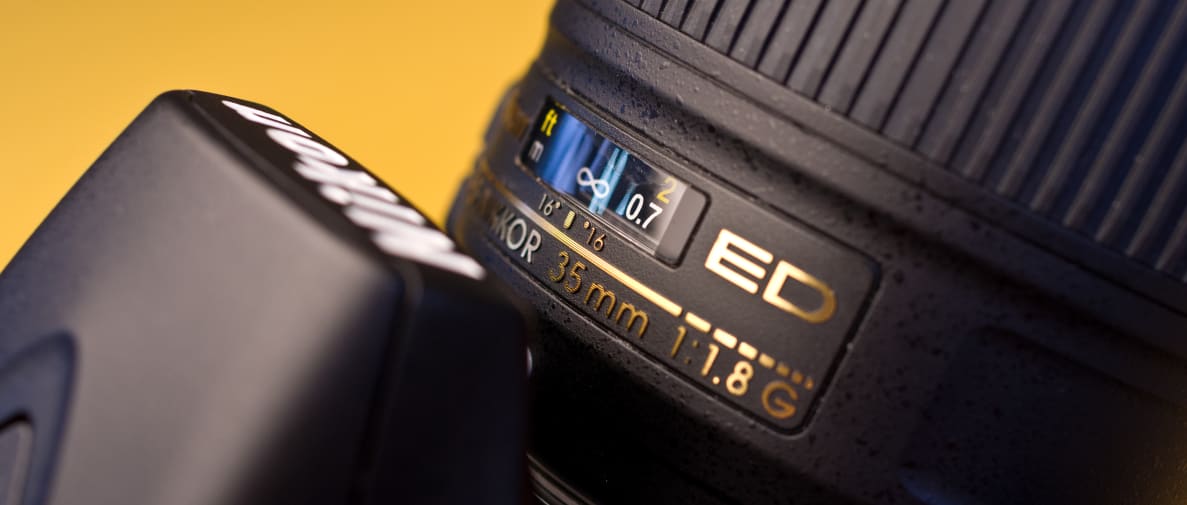Nikon now offers five different 35mm prime lenses, ranging in price from $199.95 (the AF-S 35mm f/1.8G for its DX cameras) to $1,799.95 (the AF-S 35mm f/1.4G for full-frame FX cameras). An appealing compromise between the two is the Nikon AF-S 35mm f/1.8G ED (MSRP $599.95), which provides superb performance but costs significantly less than the f/1.4 version. And since it was designed to cover the full-frame FX image sensor, it can also be used on the smaller DX sensors found in Nikon's entry-level bodies.
Both in and out of the lab, we were consistently impressed with the lens's capabilities. While most DX camera owners should probably opt for the similarly excellent (and less expensive) DX version, shooters who plan to upgrade to full-frame may be better served by going for the 35mm f/1.8G ED from the start. It's one of our favorite FX Nikon lenses for its combination of size, price, and performance.
Who's It For?
Nikon has made things a bit confusing in the last few years by producing two different 35mm f/1.8G lenses. The AF-S DX 35mm f/1.8G (which is not the one we’re reviewing here) is for entry-level DX Nikons with APS-C sensors. The AF-S 35mm f/1.8G ED (this one) is the company’s full-frame option.
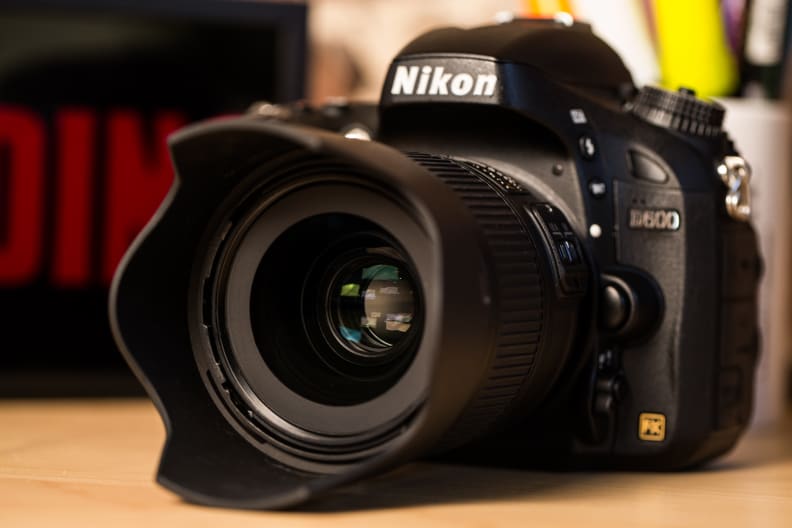
As compact and lightweight as it is, the AF-S 35mm f/1.8G ED balances well on virtually any Nikon body.
It's a wide-normal prime lens that features an internal focusing motor, a bright f/1.8 aperture, and an extra low dispersion (ED) lens element. While it's designed for FX, this lens will also work on DX-compatible bodies, where it behaves like a 52.5mm f/1.8.
If you plan to upgrade to a full-frame body soon, it might be a smart purchase. But if you're happy with your DX camera, just buy the DX lens... it'll save you about $400.
Look and Feel
Like most of Nikon’s G-series lenses, the Nikon 35mm f/1.8G ED isn’t much to look at. The build is sturdy, lightweight, and functional above all else.
The few controls are all in the right place and feel just fine, but the lens is primarily made of plastic—it feels like an "affordable" lens. Of course, while all-metal lenses have a luxurious feel, it’s the internal construction that really matters. All reports indicate that this lens is well-built inside and out, and we saw nothing to contradict them.
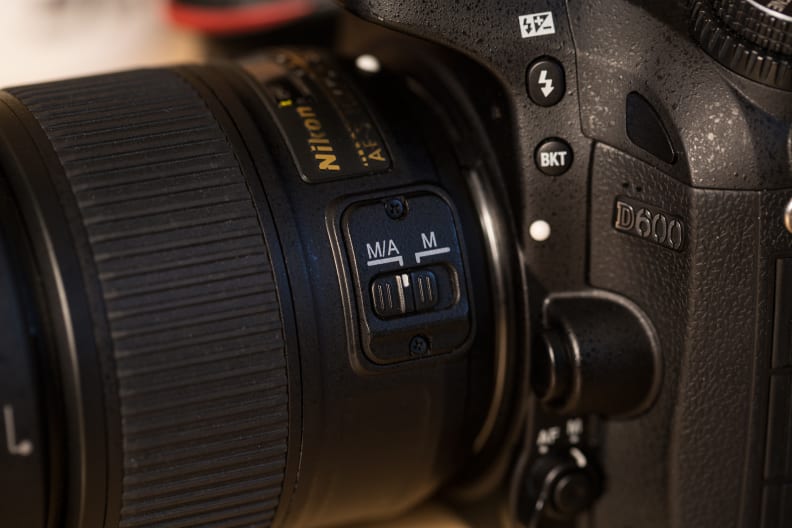
The M/A mode engages the lens's autofocus motor but lets you manually override it at any time.
The compact design and lightweight materials also make it an affable companion for a day out, even when it's mounted on a heavy hitter like the Nikon D4S or D810. Control-wise there’s not much here, but the focus ring is large and rotates smoothly. It’s a little looser than I personally like, but others may actually prefer it. Though it's focus by wire, like most modern autofocus lenses, there's solid feedback at either end so you know when you’ve hit the limits of the focusing range.
The only other physical trait worth mentioning is the focus switch, which has a full manual mode and a M/A mode autofocuses but allows you to override the AF system on the fly. On the whole, it's a good all-around lens that's simple and straightforward to operate, letting you get your shot without worrying about fiddling with too many settings.
Image Quality
Based on what we saw in our test labs, there's a lot to like about the Nikkor 35mm f/1.8G ED. At its widest aperture setting it produces great center resolution, but stop it down to f/2.8 and you'll see some of the sharpest shots you can get from any lens today.
Performance isn't quite as spectacular away from the frame center, but it's firmly within the "very good" range between f/2.8 and f/8. The only pain point is the corners at f/1.8, which are quite soft. (Granted, that's more or less expected for a lens like this.)

EXIF: 35mm, ISO 200, 1/5000, f/1.8
In the field, the 35mm f/1.8G ED impressed us with consistently beautiful images in a wide variety of lighting conditions. It's so good that we have a hard time recommending the AF-S 35mm f/1.4G—a lens that offers just a half-stop wider aperture and minor improvements to wide-open sharpness, but costs several times as much.
Below you can see sample photos taken with the Nikkor 35mm f/1.8G ED mounted on a Nikon D810. Click the link below each photo to download the full-resolution image.
Testing: Overall
When evaluating any lens, we focus on four key areas: sharpness, distortion, chromatic aberration, and bokeh. A perfect lens would render the finest details accurately, wouldn’t distort straight lines or produce ugly fringing around high-contrast subjects, and would create smooth out-of-focus areas.
In our labs, the Nikkor 35mm f/1.8G and Nikon D810 proved to be a formidable pair. The lens exhibited almost no visible chromatic aberration or distortion, with exceptional sharpness across the frame once you stop down from the f/1.8 max aperture. You'll want to use f/1.8 sparingly if you want the best performance, but this is a good, affordable all-purpose prime lens.
Testing: Sharpness
A lens's sharpness is its ability to render the finest details in photographs. In testing a lens, we consider sharpness across the entire frame, from the center of your images out to the extreme corners, using an average that gives extra weight to center performance. We quantify sharpness using line widths per picture height (LW/PH) at a contrast of MTF50.
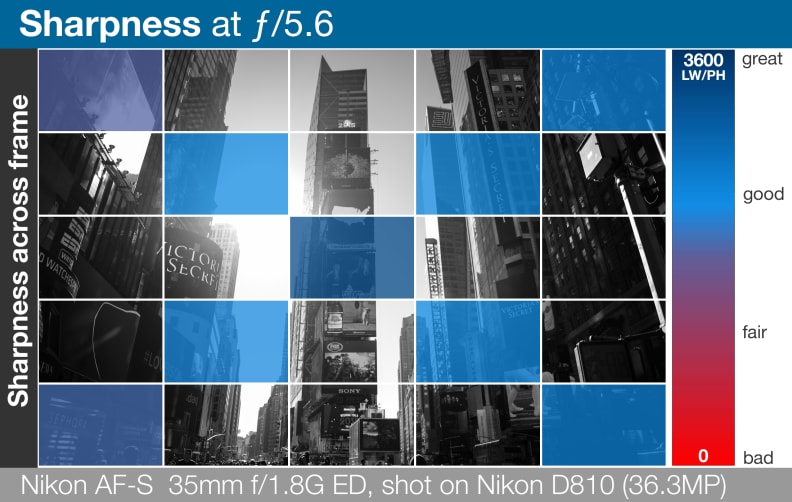
Center sharpness is excellent when the lens is stopped down to f/5.6.
Wide open at f/1.8, the 35mm f/1.8G ED isn't all that impressive compared to more expensive Nikon primes, with an average resolution of 1,620 lines and 1,712 in the frame center. Stop down a little and the center improves immediately, jumping to 1,815 lines at f/2 and all the way to 2,800 lines by f/2.8. It stays right around there until the diffraction limit kicks in, peaking at 2,930 lines from f/4 to f/5.6.
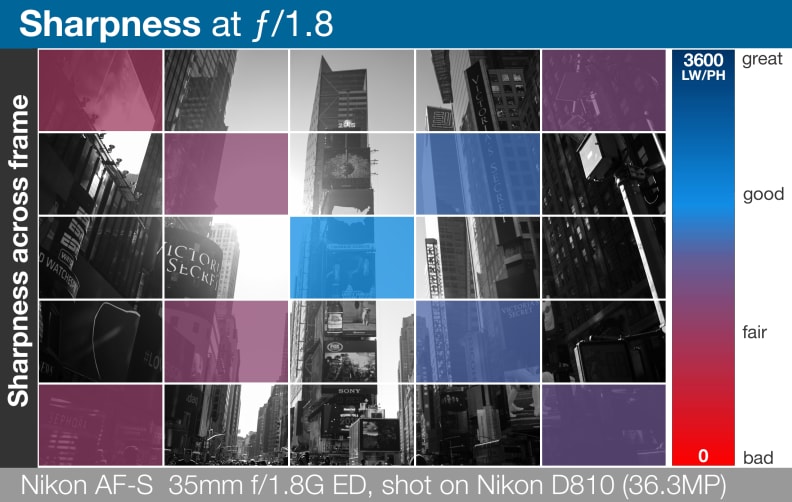
At f/1.8, the corner sharpness is a little lacking.
In the midway and corner regions we see a similar pattern. Though they crest beyond 2,300 lines at f/5.6, they tend to be around around 2,000 lines throughout the aperture range, providing sharp images regardless of settings. The exceptions are f/1.8 and f/2, where the corners are quite soft.
Testing: Distortion
We penalize lenses for distortion when they bend or warp images, causing normally straight lines to curve.
There are two primary types of distortion: When the center of the frame seems to bulge outward toward you, that’s barrel distortion. It's typically a result of the challenges inherent in designing wide-angle lenses. When the center of the image looks like it's being sucked in, that’s pincushion distortion. Pincushion is more common in telephoto lenses. A third, less common variety (mustache distortion) produces wavy lines.
Despite its relatively wide focal length (typically an invitation to barrel distortion), the 35mm f/1.8G ED produces well-corrected shots in most situations. In our test shots, the lens averaged around 0.5% barrel distortion, which is all but invisible in most shots, and can be easily fixed in post if you're a stickler about such things.
Testing: Chromatic Aberration
Chromatic aberration refers to the various types of “fringing” that can appear around high contrast subjects in photos—like leaves set against a bright sky. The fringing is usually either green, blue, or magenta and while it’s relatively easy to remove the offensive color with software, it can also degrade image sharpness.
The Nikkor 35mm f/1.8G ED produces aberrations that are minor at their very worst. You'll see fringing primarily in the corners at the widest apertures, but it never becomes a major problem and shouldn't be a concern in real-world shooting; most photos won't require any correction.
Testing: Bokeh
Bokeh refers to the quality of the out of focus areas in a photo. It's important for a lens to render your subject with sharp details, but it's just as important that the background not distract from the focus of your shot.
While some lenses have bokeh that's prized for its unique characteristics, most simply aim to produce extremely smooth backgrounds. In particular, photographers prize lenses that can produce bokeh with circular highlights that are free of aspherical distortion (or “coma”).

The 35mm f/1.8G ED's bokeh has some great features and some ugly issues. Out-of-focus points of light have a beautiful round shape when shooting at f/1.8, even with the lens's 7-bladed aperture. As is common with wide-angle lenses, however, the bokeh does look a little busy at times. Those round circles also exhibit some haloing, with bright or dark rings around the outer edges.
Conclusion
If you're a Nikon shooter looking to buy a prime lens or two, you have lots of affordable options these days. The company recently refreshed its entire lineup of primes, and now offers G-series lenses in 20mm f/1.8, 28mm f/1.8, 35mm f/1.8, 50mm f/1.8, and 85mm f/1.8 flavors. Best of all, none of those lenses costs more than $800 and most are under $600.
The 50mm f/1.8G should probably be the first prime most people pick up, but if you want something a little wider, the 35mm f/1.8G ED will also fit the bill. It's especially useful if it’s complementing something with a little more reach, like the 85mm f/1.8G.
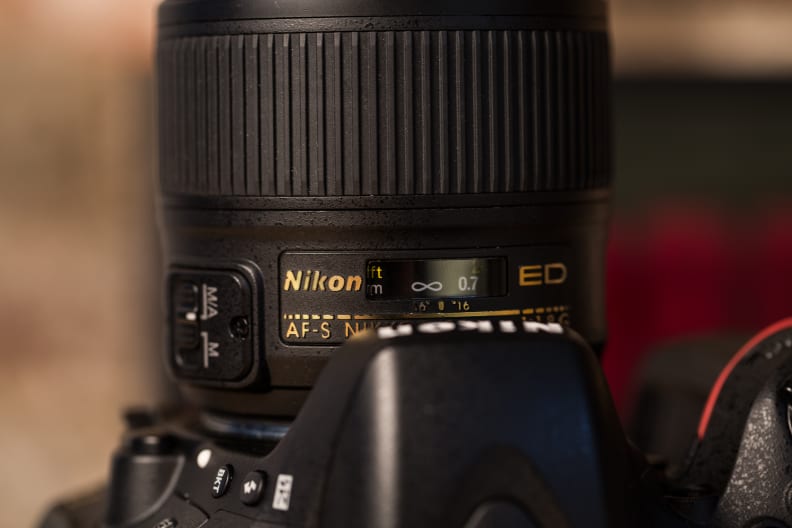
Despite its rather simple plastic construction, the lens still offers pro features like a distance scale and focus mode switch.
Nikon’s AF-S 35mm f/1.4G is an object of desire for many FX shooters, but it’s nigh unattainable at $1,800. The 35mm f/1.8 isn’t quite as good wide open, but once you stop down a bit, the lenses offer virtually identical performance. And while f/1.4 is nice in the right circumstances, the depth of field is so shallow that it can actually be difficult to work with. For most shooters, f/1.8 is plenty.
If you’re really set on an f/1.4 max aperture, look at the Sigma 35mm f/1.4, which is offers performance virtually indistinguishable from the Nikon version and only costs $900. But even then you’re still talking about a 50% markup over the AF-S 35mm f/1.8G ED. That’s $300 you could be spending on other lenses.
Meet the tester
TJ is the former Director of Content Development at Reviewed. He is a Massachusetts native and has covered electronics, cameras, TVs, smartphones, parenting, and more for Reviewed. He is from the self-styled "Cranberry Capitol of the World," which is, in fact, a real thing.
Checking our work.
Our team is here to help you buy the best stuff and love what you own. Our writers, editors, and experts obsess over the products we cover to make sure you're confident and satisfied. Have a different opinion about something we recommend? Email us and we'll compare notes.
Shoot us an email